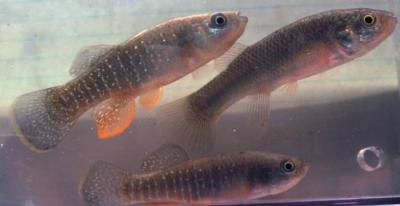Climate change is already affecting inland fish across North America — including some fish that are popular with anglers. Scientists are seeing a variety of changes in how inland fish reproduce, grow and where they can live, according to four new studies published today in a special issue of Fisheries magazine.
Fish that have the most documented risk include those living in arid environments and coldwater species such as sockeye salmon, lake trout, walleye, and prey fish that larger species depend on for food.
Climate change can cause suboptimal habitat for some fish; warmer water, for example, can stress coldwater fish. When stressed, fish tend to eat less and grow less. For other fish, climate change is creating more suitable habitat; smallmouth bass populations, for example, are expanding.
These changes will have direct implications – some good, some bad – for recreational fishers, who, in the United States alone, contributed nearly $700 million in revenue to state agencies through license, tag, stamp, and permit purchases in 2015. Annually, anglers spend about $25 billion on trips, gear, and equipment related to recreational fishing in U.S. freshwaters.
“The U.S. Geological Survey and partners are working to provide a fuller and more comprehensive picture of climate change impacts on North American fish for managers, scientists, and the public alike,” said Abigail Lynch, a lead author and fisheries biologist with the USGS National Climate Change and Wildlife Science Center.
The authors reviewed 31 studies across North America and Canada (see map) that document fish responses to climate change. The manuscripts describe the impacts of climate change to individual fish, populations, recreational fishers, and fisheries managers. One of the takeaway messages is that climate change effects on fish are rarely straightforward, and they affect warmwater and coldwater fish differently.
“Thanks to this synthesis, we can see the effects of climate change on inland fish are no longer just future speculation, but today’s facts, with real economic, social, and ecological impacts,” said Doug Austen, Executive Director of the American Fisheries Society and publisher of Fisheries magazine. “Now that trends are being revealed, we can start to tease apart the various stressors on inland fish and invest in conservation and research where these programs will really make a difference in both the short and long term.”
The authors emphasize that resource managers can take many actions to help sustain resilient fish communities and fisheries. “Even though climate change can seem overwhelming, fisheries managers have the tools to develop adaptation strategies to conserve and maintain fish populations,” said Craig Paukert, a lead author and fisheries scientist at the USGS Missouri Cooperative Fish and Wildlife Research Unit at the University of Missouri.
Smallmouth bass (see photo) provide one example of how climate change presents fisheries managers with both challenges and opportunities. Smallmouth bass, a popular recreational species, are expanding their range northward with climate change. This expansion can disrupt existing food webs but it also creates new prospects for recreational fishing. Because many recreational fishers want to catch smallmouth bass, managers may need new management techniques to accommodate the increased fishing demand while still maintaining the native coldwater fish communities. Consequently, said Paukert, the management process may likely be an exercise in managing expectations of the stakeholders for fisheries changing with climate change.
Other major findings:
- Climate change may be altering abundance and growth of some North American inland fishes, particularly coldwater fish such as sockeye salmon, a species experiencing well-documented shifts in range, abundance, migration, growth, and reproduction.
- Climate change may be causing earlier migration timing and allowing species that never occurred together previously to hybridize. For example, native westslope cutthroat trout in the Rocky Mountains are now hybridizing with rainbow trout, a non-native species.
- Shifts in species’ ranges are already changing the kinds of fish in a specific water body, resulting in new species interactions and altered predator-prey dynamics. For example, in Canada, smallmouth bass have expanded their range, altering existing food chains because the species compete against other top predators for habitat and prey fish.
- Droughts are forecasted to increase in frequency and severity in many parts of North America, especially in arid rivers. Such droughts exacerbate the impacts of water flow regulation in ways that affect people, fish, and aquatic systems.
“The current state of the science shows that climate change is impacting fish in lakes, rivers, and streams, but knowing that is just the first step in effectively addressing the changes to these important natural resources and the communities which depend upon them,” Lynch said.
The following papers are available in Fisheries magazine, published by the American Fisheries Society:
- Physiological basis of climate change impacts on North American inland fishes, authored by James E. Whitney (Pittsburg State University), Robert Al-Chokhachy (USGS), Bo Bunnell (USGS) and others.
- Climate change effects on North American inland fish populations and assemblages, authored by Abigail J. Lynch (USGS), Bonnie J. E. Myers (USGS), Cindy Chu (Ontario Ministry of Natural Resources and Forestry; OMNRF) and others.
- Identifying alternate pathways for climate change to impact inland recreational fishers, authored by Len M. Hunt (OMNRF), Eli P. Fenichel (Yale University), David C. Fulton (USGS) and others.
- Adapting inland fisheries management to a changing climate, authored by Craig P. Paukert (USGS), Bob A. Glazer (Florida Fish and Wildlife Conservation Commission), Gretchen J. A. Hansen (Minnesota Department of Natural Resources) and others.

